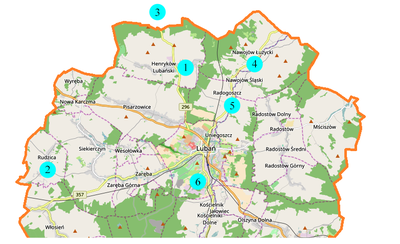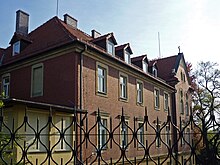Magdalen convent Lauban
The Magdalenerinnenkloster Lauban was a monastery of the Magdalenerinnen within the city wall of the Upper Lusatian six-town Lauban (today Lubań in the Polish Voivodeship of Lower Silesia ). It was bombed out in 1945 in the battle for Lauban and almost completely removed after the war.
history
The founder of the monastery, Heinrich von Jauer, determined in his deed of foundation of January 8, 1320 that the new monastery in Lauban should not be built until the position of pastor Christian of the Lauban parish church has been completed. The monastery was to be occupied with Magdalena from the already existing Magdalena convent in Naumburg am Queis . The new monastery was built on a site between the churchyard wall and the city wall north of the Trinity Parish Church, which was then over 100 years old. During the Hussite Wars in 1427 the town and monastery burned down. Further fires in 1488 and 1499, as well as the great city fire of 1554, sometimes caused very high damage.
After the Reformation , only four of the order's numerous monasteries remained: the one in Lauban in Upper Lusatia, not least thanks to Johann Leisentrit's wise church policy , as well as two in Silesia (Naumburg am Queis and Sprottau am Bober ) and one in Hildesheim . Since 1527 the Trinity Church has been allowed to be used as a simultaneous church. In 1616 the prioress Christina Meurer decided to build a small public St. Anna chapel, which could also be visited by residents of the Catholic faith. The monastery in Lauban suffered further fires in 1659 and 1670, which was followed by extensive construction work, including extensive construction work, particularly between 1700 and 1712. In 1710 the St. Anna Church was rebuilt. After the last great city fire in 1760, stone vaults were increasingly built in and fireproof tile roofing was added around 1800. The former Trinity parish church was almost completely destroyed in 1760, remained in ruins for a long time and was never rebuilt. When it was finally demolished by 1879, only the church tower remained, which functioned as a bell tower until 1945 and is still there today.
Following the resolutions of the Congress of Vienna , Lauban became Prussian in 1815 and incorporated into the province of Silesia in the following years . Prioress Maria Ignatia Kittel succeeded in averting secularization of the monastery, as had been carried out in many places since 1810 in the places that had become Prussian as a result of the Silesian Wars , for example in the Cistercian Abbeys of Grüssau and Leubus Monastery . However, the monastery had to take on tasks in nursing and girls' education. Until 1821, the monastery was still under the episcopal administrator and visitor in Bautzen . After that, the papal bull De salute animarum changed the boundaries of the dioceses. From now on the respective prince-bishop of Wroclaw was responsible for the monastery in Lauban. After the Lauban vice-priest Johannes Mahr, who came from Nebelschütz and was appointed by Bautzen, died in 1848, the prince-bishop of Breslau was able to appoint a successor here: the pastor of Jätschau (now Jaczów in the rural community of Jerzmanowa ), Adalbert Anter. In 1885, Lauban founded a subsidiary convent in Studenitz in Lower Styria (today Studenice in Slovenia ). From 1922 to 1924, the Grüssau prior Nikolaus von Lutterotti worked as a spiritual for the Laubaner Magdalenerinnen.
At the suggestion of the monastery, under the architect Alexis Langer, a new building for the Trinity Church was built in the northern monastery grounds between 1857 and 1861. In World War II the city Lauban in February and March 1945 destroyed about 60 percent. The monastery was also badly affected and in the following years almost completely demolished. The New Trinity Church was able to be rebuilt and now serves as a Catholic church. The sisters expelled from Lauban gathered in Obernzell in 1945 and continued their monastic life in Rotthalmünster from July 1945 . From 1947 to 1952 they looked after the institute of the Congregatio Jesu in Simbach am Inn, which was set up as an auxiliary hospital . The sisters from Lauban founded a new monastery in 1951 on a property acquired by Count Ludwig von Freyen-Seyboldsdorf in Seyboldsdorf in the Lower Bavarian district of Landshut . The monastery existed until 2004.
In Luban a new monastery of the Polish branch 1953 of the Magdalene channels (Magdalenki; siostry św Marii Magdaleny od Pokuty.) In the former St. Anthony pin of the Congregation of the Sisters of Saint. Elisabeth (the Gray Sisters ). The monastery still exists today as a mother monastery. From here Magdalenerinnen work in Breslau , Jelenia Góra , Legnica and Rewal , but also again in Germany (Bayreuth, Frankfurt am Main, Erfurt).

Monastery villages, estates and farms
From the beginning the three monastery villages Hennersdorf (today Henryków Lubański), Pfaffendorf (today Rudzica, a place of the municipality Siekierczyn ) and Wünschendorf (today Radogoszcz ) as well as a small part of the village Kerzdorf (today Księginki and since 1954 a district of Lubań ) belonged to the monastery ). Farmers, gardeners and cottagers were subject to interest and robots . They were also obliged to perform manual and clamping services . In 1738 the monastery bought the village of Günthersdorf (today Godzieszów in the Nowogrodziec parish in the Bolesławiecki district ) and thereby also acquired the right of patronage over the church there. In 1756 a 300-hectare estate with a castle and commercial ancillary businesses was acquired in Sächsisch Haugsdorf (today Nawojów Łużycki). The estate was previously owned by the city of Lauban.
Since 1905 the monastery ran a basalt works together with an engineer . Due to the necessary renovation around 1930 and the purchase of Miketta's Gut Eichenhof in Niederschreibersdorf (today Pisarzowice Dolne), bonds were raised in Dutch guilders . The Eichenhof was soon abandoned due to high costs. A repurchase of the bonds in 1933 by the then provost Karl Heisig led to an indictment of alleged foreign exchange offenses. Heisig was sentenced in 1935 to a heavy fine and prison sentence, which was, however, considerably softened in the same year.
Prioresses of the monastery until 1828
In brackets, year of certification (U) or term of office
|
|
See also
literature
- Paul Skobel: The virgin monastery monastery of St. Mary Magdalene of the penance at Lauban in Silesia from 1320-1821 . Edited and supplemented to the present by Edmund Piekorz. Konrad Theiss, Aalen and Stuttgart 1970.
Individual evidence
- ↑ Paul Skobel: The virgin monastery monastery of St. Mary Magdalene of the penance at Lauban in Silesia from 1320-1821 . Edited and supplemented to the present by Edmund Piekorz. Konrad Theiss, Aalen and Stuttgart 1970. p. 66ff.
- ↑ Norbert Kersken: The Upper Lusatia from the establishment of the six-city federation to the transition to the Electorate of Saxony (1346-1635) . In: Joachim Bahlcke (Hrsg.): History of Upper Lusatia: Rule, society and culture from the Middle Ages to the end of the 20th century. 2nd Edition. Leipziger Universitäts-Verlag, Leipzig 2004. ISBN 3-935693-46-X . P. 130.
- ↑ Paul Skobel: The virgin monastery monastery of St. Mary Magdalene of the penance at Lauban in Silesia from 1320-1821 . Edited and supplemented to the present by Edmund Piekorz. Konrad Theiss, Aalen and Stuttgart 1970. pp. 85ff.
- ↑ Paul Skobel: The virgin monastery monastery of St. Mary Magdalene of the penance at Lauban in Silesia from 1320-1821 . Edited and supplemented to the present by Edmund Piekorz. Konrad Theiss, Aalen and Stuttgart 1970. p. 314.
- ↑ Paul Skobel: The virgin monastery monastery of St. Mary Magdalene of the penance at Lauban in Silesia from 1320-1821 . Edited and supplemented to the present by Edmund Piekorz. Konrad Theiss, Aalen and Stuttgart 1970. p. 338.
- ↑ Magdalenian women in OrdenOnline (accessed on February 1, 2020)
- ↑ Reuerinnen in: Historisches Lexikon Bayerns (accessed on February 1, 2020)
- ↑ St. Benedikt Bayreuth (accessed February 1, 2020)
- ↑ Contact Homepage of the Magdalenki in Polish (accessed on February 5, 2020)
- ^ Karlheinz Blaschke and Uwe Ulrich Jäschke: Kursächsischer Ämteratlas 1790. Verlag Klaus Gumnior, Chemnitz 2009. ISBN 978-3-937386-14-0 . Pp. 119, 120.
- ↑ Paul Skobel: The virgin monastery monastery of St. Mary Magdalene of the penance at Lauban in Silesia from 1320-1821 . Edited and supplemented to the present by Edmund Piekorz. Konrad Theiss, Aalen and Stuttgart 1970. p. 31.
- ↑ Paul Skobel: The virgin monastery monastery of St. Mary Magdalene of the penance at Lauban in Silesia from 1320-1821 . Edited and supplemented to the present by Edmund Piekorz. Konrad Theiss, Aalen and Stuttgart 1970. p. 43.
- ↑ Thomas Mengel: The fate of the Silesian women's monasteries during the Third Reich and 1945/46. Böhlau, Cologne 1986. ISBN 3-412-03485-1 . P. 5.
- ↑ Thomas Mengel: The fate of the Silesian women's monasteries during the Third Reich and 1945/46. Böhlau, Cologne 1986. ISBN 3-412-03485-1 . P. 6ff.
- ↑ Paul Skobel: The virgin monastery monastery of St. Mary Magdalene of the penance at Lauban in Silesia from 1320-1821 . Edited and supplemented to the present by Edmund Piekorz. Konrad Theiss, Aalen and Stuttgart 1970. pp. 395ff.
- ↑ Paul Skobel: The virgin monastery monastery of St. Mary Magdalene of the penance at Lauban in Silesia from 1320-1821 . Edited and supplemented to the present by Edmund Piekorz. Konrad Theiss, Aalen and Stuttgart 1970. pp. 170ff.
Web links
- http://www.magdalenki.pl (homepage in Polish)
Coordinates: 51 ° 7 ′ 18 ″ N , 15 ° 17 ′ 32 ″ E


